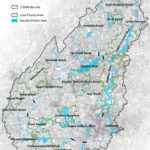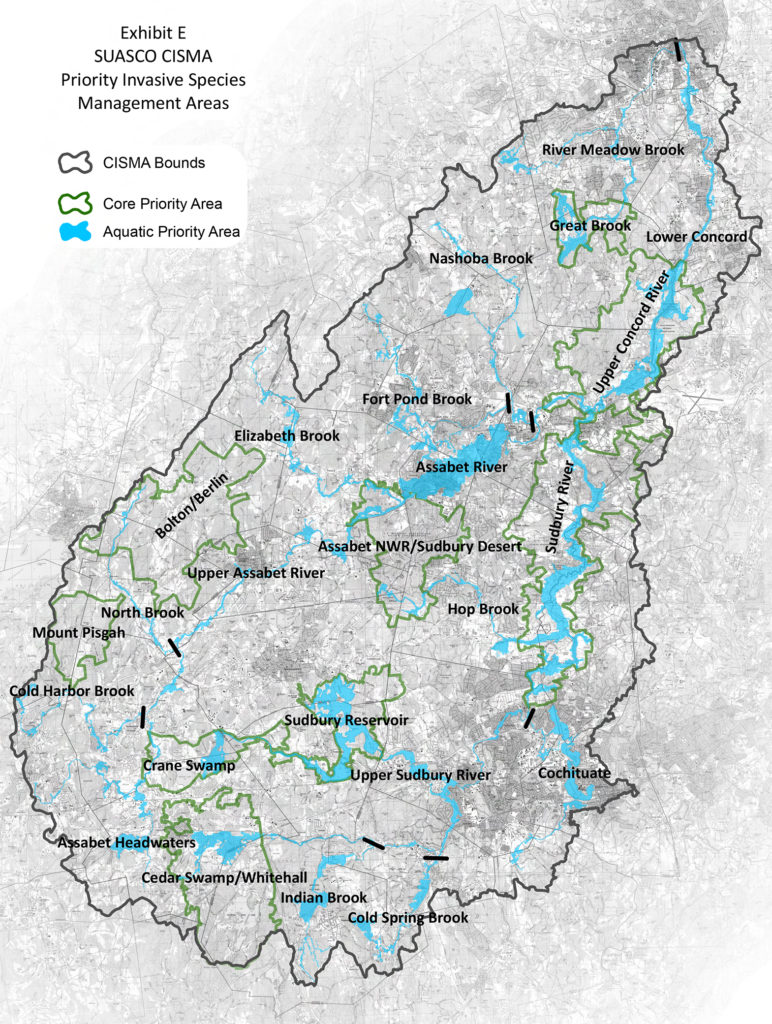
By Jeffrey North
New York state has eight very large ones. Oregon has 10. Michigan has more than 20 (required by law for every county). The number of Comprehensive Invasive Species Management Associations (CISMAs) across the country is approaching 400. Massachusetts has one. But that number is likely to increase. With the likely passage of the invasive species bill (H4595), financial and administrative resources will be available for CISMAs and a host of other programs, plans, and projects for controlling invasive plants.
The bill would establish an invasive species trust fund. A statewide invasive species coordinator would be appointed, along with an invasive species advisory committee composed of representatives of the Massachusetts Audubon Society, The Nature Conservancy, the Massachusetts Rivers Alliance, the Trustees of Reservations, and a dozen more nonprofit institutions and state offices.
Operating within the Executive Office of Energy & Environmental Affairs, the invasive species coordinator and the advisory committee will promote the ecological integrity of the state’s lands and waterways via mechanisms including the development and support of CISMAs. This new office will develop and implement a statewide strategic management plan for invasive species. More than just pulling weeds, the management plan would also drive research and pilot projects to test new and emerging technologies for controlling invasives.
What Is a CISMA?
A CISMA is a partnership of federal, state, and local government agencies, tribes, individuals, and interested groups that manage invasive species (or weeds) in a defined area. These partnerships are also known in other parts of the country as Cooperative Weed Management Areas (CWMAs) or Partnerships for Regional Invasive Species Management (PRISMs) in New York.
CISMAs are created to address threats posed by invasive species at landscape scales, fueled by collaboration between landowners and land managers with a mission to manage and raise awareness about invasive species in a region or a watershed. CISMAs conduct surveillance and mapping of invasive species infestations. They locate and treat new infestations early and respond rapidly, and they restore habitats. CISMAs educate stakeholders on invasive species and the costs of just letting nature take its course—to the detriment of biodiversity. Typically, there is a lot of partner coordination and volunteer recruiting and training to do.
CISMAs also support research through citizen science in collaboration with research organizations and universities. They act as regional communication centers and hubs for best practices.

Map of the watersheds inlcuded in the Sudbury, Assabet, and Concord Comprehensive Invasive Species Management Association (CISMA). Source: SUASCO
Massachusetts has a model
Just a few miles to the west of Belmont, the Sudbury, Assabet, and Concord (SuAsCo) CISMA is a partnership that works across 36 cities and towns to manage and control invasive species in three watersheds. Established in 2009, its 40+ partner organizations include 15 conservation commissions, land trusts, garden clubs, Framingham State University, the National Parks Service, town governments, and the US Fish & Wildlife Service. The three watersheds cover approximately 377 square miles and include upland and wetland habitats, historic and scenic sites, and recreational areas. This CISMA protects the biological, aesthetic, cultural, historical, and recreational values of natural areas, farmland, water resources, and scenic vistas by cooperating, coordinating activities, and sharing resources to prevent and control invasive species on public and private lands.
SuAsCo hosts spring and fall meetings with speakers on subjects like knotweed management and using goats to eat invasive plants. At meetings, each partner organization shares what they are working on, and a monthly newsletter keeps the CISMA partners looped in and informed on available training, conservation topics, and invasive species knowledge. Management plan workshops teach partners and volunteers how to build a plan for their town and conservation properties.
The new and rapidly expanding Weed Warriors Program educates and supports volunteers who work independently to control invasives. Grant funding from the Wild & Scenic Rivers Stewardship Council, run by the River Network and the US Forest Service, supports partners’ efforts to create management plans, engage school groups, purchase and plant native species, and create educational signage.
To learn more about the SuAsCo CISMA, visit cisma-suasco.org.
Next Steps
If you are alarmed by the seemingly sudden plethora of knotweed, bittersweet, garlic mustard, and black swallowwort outcompeting and overwhelming native plants, help is at hand. The invasive species bill (H4595) is currently before the Joint Committee on Ways and Means, the final stage before passage of the bill. Timing is uncertain, but passage into law is optimistically anticipated, according to Kira Arnott, chief of staff for Representative Dave Rogers’s office. The House bill was originally presented by Representative Rogers while the corresponding Senate bill was authored by Senator Patricia Jehlen.
Readers can suggest to friends and family living in other districts that they contact their legislators to indicate support for the bill. In the meantime, the Invasive Working Group of the Belmont Land Management Committee has been established to oversee removal of invasive plant species on Belmont’s Lone Tree Hill conservation land. Check the Belmont town calendar for the dates of Invasive Working Group meetings and watch for upcoming volunteer opportunities.
Jeffrey North is managing editor of the Belmont Citizens Forum Newsletter, the ex-officio Belmont Conservation Commission representative on the Land Management Committee for Lone Tree Hill, and chair of the Land Management Committee’s Invasives Working Group.


Sorry, the comment form is closed at this time.